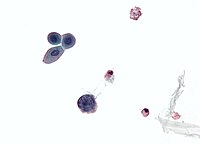
Photo from wikipedia
Verotoxin-producing Escherichia coli (VTEC) causes zoonotic infections, with potentially devastating complications, and children under 5 years old are particularly susceptible. Antibiotic treatment is contraindicated, and due to the high proportion… Click to show full abstract
Verotoxin-producing Escherichia coli (VTEC) causes zoonotic infections, with potentially devastating complications, and children under 5 years old are particularly susceptible. Antibiotic treatment is contraindicated, and due to the high proportion of infected children that suffer from severe and life-changing complications, there is an unmet need for a vaccine to prevent VTEC infections. Bacterial adhesins represent promising candidates for the successful development of a vaccine against VTEC. Using a proteomic approach to identify bacterial proteins interacting with human gastrointestinal epithelial Caco-2 and HT-29 cells, we identified eleven proteins by mass spectrometry. These included a glutamine-binding periplasmic protein, GlnH, a member of the ABC transporter family. The glnH gene was identified in 13 of the 15 bovine and all 5 human patient samples tested, suggesting that it is prevalent. We confirmed that GlnH is involved in the host cell attachment of an O157:H7 prototype E. coli strain to gastrointestinal cells in vitro. Recombinant GlnH was expressed and purified prior to the immunisation of mice. When alum was used as an adjuvant, GlnH was highly immunogenic, stimulating strong serological responses in immunised mice, and it resulted in a modest reduction in faecal shedding but did not reduce colonisation. GlnH immunisation with a T-cell-inducing adjuvant (SAS) also showed comparable antibody responses and an IgG1/IgG2a ratio suggestive of a mixed Th1/Th2 response but was partially protective, with a 1.5-log reduction in colonisation of the colon and caecum at 7 days relative to the adjuvant only (p = 0.0280). It is clear that future VTEC vaccine developments should consider the contribution of adjuvants in addition to antigens. Moreover, it is likely that a combined cellular and humoral response may prove more beneficial in providing protective interventions against VTEC.
Journal Title: Vaccines
Year Published: 2023
Link to full text (if available)
Share on Social Media: Sign Up to like & get
recommendations!